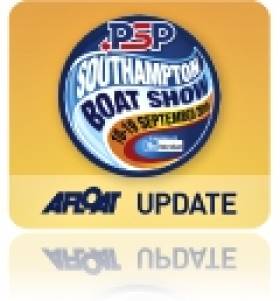Displaying items by tag: Andrew Simpson
Knox Johnston Leads The Way for 'Barts Bash' On The Solent
#bartsbash – A sailing legend and alumni of round the world ocean racers took to the Solent at the weekend as one of the largest entries in the global record-breaking attempt Bart's Bash, to raise funds for the Andrew Simpson Sailing Foundation (ASSF).
Over 130 former Clipper Round the World Yacht Race crew and skippers spanning nine race editions over 19 years were joined by renowned yachtsman and Clipper Race chairman, Sir Robin Knox-Johnston on the 24.8 mile course from Gosport on the South Coast, specially created for the Bart's Bash event.
Nine of the new fleet of twelve identical stripped-down Clipper 70-foot ocean racing yachts took part in Bart's Bash, the first time so many Clipper 70s have been on the water racing since the 11-month, 40,000-mile long Clipper Race finished earlier this year.
Sir Robin remarked: "It was a fantastic day to get the Clipper 70s out on the water and it was a pleasure to see many familiar Clipper Race faces return to Gosport once again. We had perfect sailing conditions and many experienced ocean racers competing which made the race very close and exciting, with the lead changing quite a lot. Well done to all our racers."
More than 17,000 sailors, representing over 600 clubs worldwide participated in Bart's Bash on Sunday with the Clipper Race Yacht Club (CRYC) ranked eleventh overall. The Clipper Race Yacht Club was set up in 2009 and has over 840 members worldwide. It is the only club in the world that requires an ocean crossing qualification and has more circumnavigators in its membership than any other club.
So far, Bart's Bash has raised £166,716.42 for the ASSF worldwide and it has provisionally set a new Guinness World Record for the 'largest sailing event in 24 hours.'
Sir Robin added: "Congratulations to the team at the Andrew Simpson Sailing Foundation for creating such a successful, global sailing event. It was a proud moment for all at the Clipper Race Yacht Club to be able to join together, be part of history and raise funds for the first ever Bart's Bash."
Founded by Sir Ben Ainslie, Iain Percy OBE, and Andrew Simpson's wife Leah, in Andrew's memory, the Andrew Simpson Sailing Foundation aims to create transformational life opportunities for young people through sailing, in the UK and around the world, a philosophy shared closely by the Clipper Race.
Recently Sir Robin Knox-Johnston announced the donation of a crew spot for Leg 6, the Pacific Ocean crossing in the Clipper 2015-16 Race to the Andrew Simpson Sailing Foundation, with patron Sir Ben Ainslie joining him to reveal the contest details. Open to all UK based 18-24 year olds, regardless of previous sailing experience, they just need to be nominated for the challenge. The contest closes on 14 November. Click here for more information, and how to apply. www.andrewsimpsonfoundation.co.uk/news
Southampton Boat Show 2014 Opens for Business
#southamptonboatshow – Olympic sailor Iain Percy together with Freddie and Hamish Simpson, the children of British sailing gold medalist Andrew "Bart" Simpson, who died during training for the America's Cup, TV presenter Matt Baker and children from the The Andrew Simpson Sailing Foundation, open the PSP Southampton Boat Show 2014, with "Bart's" boys helping to cut the ribbon.
The 12-21 September 2014 marks a unique date in the boating calendar, the 46th boat show in Southampton. The PSP Southampton Boat Show 2014, a festival of boating, will host almost 150 boat debuts, thousands of brands, boats, products and suppliers and features one of Europe's largest purpose-built marinas with over 2km of pontoons.
The home of the 2012 sailing Olympic regatta, the Weymouth and Portland National Sailing Academy (WPNSA) has announced a prestigious new collaboration with the 'Andrew Simpson Sailing Foundation' (ASSF). The ASSF founded by the Academy's Director, Sir Ben Ainslie, Iain Percy OBE and Andrew's wife Leah to honour his life and legacy, will be opening the 'Andrew Simpson Sailing Centre' at the same venue where Andrew 'Bart' Simpson competed during the Olympic Games.
The Weymouth and Portland National Sailing Academy, based in Andrew's home county of Dorset, will act as a hub for all of the Andrew Simpson Sailing Foundation's activities, helping the Foundation fulfil its charitable objectives. The RYA accredited Centre will open in May 2014 offering a range of sailing courses for young people, community organisations and adults; including programmes for schools, as well as club sailors.
Peter Allam, Chief Executive at the Weymouth and Portland National Sailing Academy explains the relevance to the local community; 'the ASSF has agreed to work closely with the Academy and the Chesil Trust to deliver the 'Rod Shipley Sail for a Fiver' scheme which has to date assisted 12,000 local children to experience sailing on the waters of Portland Harbour. The scheme has run successfully for 10 years and currently introduces 1,500 children to water sports annually. The Academy is committed long term to inspiring the next generation through sailing. Working in hand with the ASSF, this relationship will make a significant contribution to the ongoing development of the Olympic and Paralympic sailing legacy here at the WPNSA'.
Amanda Simpson, Andrew's sister and a Trustee of the Andrew Simpson Sailing Foundation as well as being an accomplished sailor in her own right commented, 'this is a fantastic opportunity for ASSF to engage with grass roots sailing in a place where Andrew spent much of his youth and adult sailing life. We look forward to working with local and national communities to make this venture at the WPNSA a huge success'.
#AmericasCup - Andrew 'Bart' Simpson died from "blunt trauma with drowning" after the Artemis Sailing catamaran capsized and broke apart during training ahead of the America's Cup this summer.
That was finding of the medical examiner's report into the tragic incident on 9 May released last week, as Euronews reports.
The 36-year-old double Olympic medalist suffered multiple head blows when the 72-foot racing vessel capsized on top of him during a training run on San Francisco Bay.
As previously reported on Afloat.ie, Simpson was trapped beneath the boat and died despite desperate efforts to revive him. All other members of the 11-strong crew of the AC72 were recovered.
However, report into Simpson's death did not establish the exact sequence of events the led to the capsize, nor explain why Simpson was unable to get out from under the vessel.
And its findings have been disputed by Chuck Hawley, one of the America's Cup incident investigation panel, who believes the catamaran's main crossbeam broke before the boat collapsed on itself, trapping Simpson within the structure.
Euronews has much more on the story HERE.
As the America's Cup moves into a new phase, and many say a troubled one, here's a fitting tribute to the memory of Andrew Simpson, killed last month in a tragic America's Cup sailing accident on San Francisco Bay.
In a shocking day for sailing and the America's Cup, Artemis Racing has confirmed the tragic death of crew member Andrew "Bart" Simpson during training in San Francisco yesterday.
Andrew Simpson (36), a British double Olympic medalist, was one of the 11-man crew aboard Artemis Racing's AC72 catamaran which capsized during training on San Francisco Bay ahead of this summer's America's Cup. All other crewmembers are accounted for.
Simpson, however, was trapped underneath the boat and despite attempts to revive him, by doctors afloat and subsequently ashore, his life was lost.
"The entire Artemis Racing team is devastated by what happened," said CEO Paul Cayard. "Our heartfelt condolences are with Andrew's wife and family."
He was sailing alongside childhood friend and Olympic sailing partner Iain Percy, the Artemis team's director and tactician. He had moved to San Francisco six weeks ago to take up the Cup challenge
Simpson had won two Olympic medals, including a gold medal at the 2008 Beijing Games and silver in last year's Games in London, both in the Star keel boat class.
Simpson speaks to the press at the Sail for Gold Regatta last year, weeks before the Games
He was awarded an MBE in the 2009 New Year Honours list.
Born in Chertsey, Surrey, Simpson started sailing at the age of six with his father in Christchurch, Dorset.
Tributes have poured in from the world of sailing and beyond.
The Royal Yachting Association (RYA) and British Sailing Team said they were "devastated" by the news.
Afloat.ie expresses our deepest condolences to Simpson's family, friends and his teammates.


































































